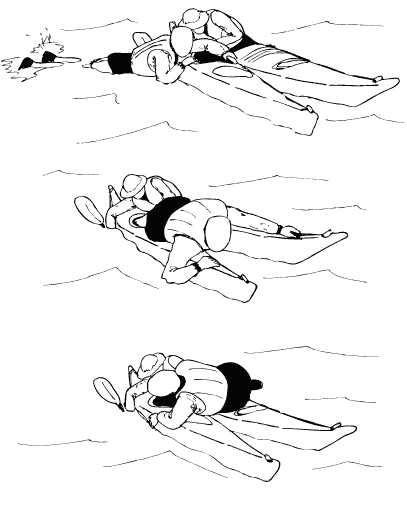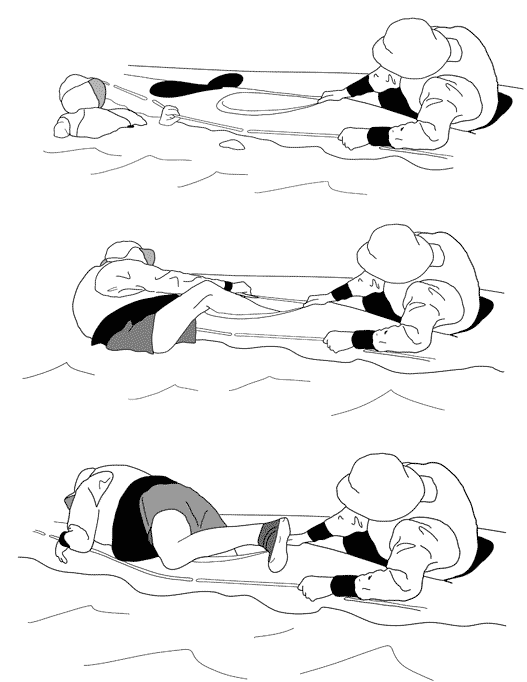Over...and Still Out?
some time ago I read in Sea Kayaker (February 1995, p 61) a not very complimentary review by Roger Schumann of a UK video on sea kayak rescues by one Gordon Brown. I did not see the video until much later, but I can only say that I agree with the review: it is a video of value only for learning what not to do.
Rather than try to repeat Schumann’s critique, let me try to be positive by describing the only rescues I am happy with, and which are described in Paddle Australia Qualification Scheme documentation. The Scheme assumes these rescues and specified that kayaks used for Sea Kayak Skills and above be equipped with ‘pump or bailer capable of ‘no hands’ operation’ (page 10), along with full decklines and other equipment.
Firstly, some general points. In sea kayaking there is the philosophy: ’You got yourself into this, you get yourself out of it.’ Self sufficiency. From that there follow some axioms with obvious implications for kayak design and rescue methods:
- The kayak must be controllable in all conditions with the cockpit flooded
- Rescue methods must not require direct lifting
- Self rescue must be possible without the use of extra, redundant, equipment
- The kayak must remain controllable with water in the hull compartment(s)
It’s taking a while for some lessons to be learned. Look at sea kayak incident reports and you’ll see the same pattern repeated: swamped kayaks that could not be managed (See the Addendum below). Minimise the effects of swamping and you reduce the risks. That means minimum volume cockpits, hands free pump systems, and adequate decklines. Everything must be reliable: the more bits and pieces you add, the less reliable the whole system will become. To start with a cockpit holding 150 litres or so and then add manual pumps, or complex rescues, is the wrong approach. Much better to start with 100 litres or less (80 is achievable) so that flooding has a minimal effect on handling, and using pump systems that can be used with both hands on the paddle.
Why do capsizes occur? Because paddlers are in conditions beyond their normal capabilities. Of course, there is a wide range of conditions and capabilities: a flat calm can be precarious to a beginner trying some strokes for the first time, while it may be Force 6 on the open sea to others. Whatever, the rescue must be achieved in the conditions that caused the capsize, and often those conditions will be sufficient to damage boats and people. The rescue will also put the paddler back into the conditions that led to the problem in the first place: that means you will still have trouble paddling, let alone fiddling around with bits and pieces. After a rescue you may well have to consider turning back or making a forced landing before there is more trouble.
A rescuer’s priority is always the victim. Talk to the victim using clear, concise, instructions, and keep an eye on his state of mind and body. If his paddle drifts away, let it. Chase it afterwards or send someone else after it. Anything else that drifts away probably deserves to be lost. (Of course it may just as well be ‘her’. Substitute as required.)
Rescue methods
The first method is the simplest. The victim rights his boat and waits on its bow. The rescuer approaches so that the two boats are facing opposite directions, and stabilises the kayak for the paddler to re-enter. When he is aboard, spraycover on and paddle away, while letting the pump do the work.
This flip and pump rescue is the only one to consider for doubles. Any attempt at lifting or manhandling them is simply asking for trouble.
Method two we call the Wedge Rescue, because we use the shape of the bow to do the lifting. Use this method if you want to empty the boat before putting the paddler back in. As with the flip and pump rescue, the paddler rights his boat and waits on the bow.

The rescuer approaches to pick up paddler and the bow of his boat in one move. The victim transfers to the rescuer’s bow. The rescuer, with the two boats at an angle of 45–60 degrees simply grabs the boat by the deckline and pulls, timing the pull to let waves do some of the work, and to avoid being speared. When the cockpit is clear of the water, he pushes the boat forward on the deck and rolls the boat towards himself, and the cockpit drains.
He then pushes the kayak back into the water and lines it up for re-entry.
The Swimmer Assisted Rescue is common in the eastern states of Australia. For this rescue, the victim leaves the boat inverted and waits at the stern. The rescuer approaches the bow of the boat, and the victim pushes down on his end so that the bow rises. The rescuer then takes over, rolling the kayak to empty it, then lining it up for re-entry.

Re-entry

The simplest method is still effective. With the kayaks facing in opposite directions, the rescuer leans on the victim’s foredeck so that the peak of the deck is in his armpit. The more weight on the deck, the more stable it is. Alternatively, reboard over the rescuer’s boat. A good breaststroke leg action does most of the work. Don’t sit up too soon: keep your weight low by lying on the deck until you have your legs in the cockpit, as in the diagram.

Another method is the Heel Hook, whch gains effectivness by using leg muscles. Start alongside, facing the bow, feet near the surface. Reach across with the outside hand, right in the diagram, to the deckline or cockpit rim on the opposite side. Put the outside foot, right in this case, into the cockpit. Using leg and arm muscles, lift up on to the deck. Put the other foot into the cockpit, roll face up and sit up.
What to do with the paddles
The last thing you want is a paddle getting in the way, or, worse, being damaged in the process. Either put it into a paddle park and toss it out of the way, or give it to the victim to hold while you begin the rescue. When the time comes for re-entry, take both paddles and hold them under the hull clear of the re-entering paddler. In the reboarding diagram above the rescuer’s paddle is leashed, and the rescuer is holding the victim’s paddle.
Self rescue
There is only one: re-entry and roll. No messing about with redundant rubbish; in, up, go. Yes, your rolling must be reliable, but if it isn’t, what are you doing in a situation where you need an unassisted rescue?
The advocates of paddle floats and similar contrivances should be made to demonstrate in winds of at least 25 kn with a decent chop, not the flat calm we see in Over... and Out. The fatal flaw of their methods is that there is no safe way of stowing everything afterwards. If you can’t paddle normally in the state of wind and sea that threw you in how can you sit and mess about with things, especially if they’re behind you? The crippled paddle rescue fans suggest lots of practice to make it reliable. I’d suggest more practice with paddling and bracing skills, together with a bit of seamanship.
Things you can throw away or forget
Manual pumps, hand-held pumps, paddle floats, paddle wings, paddle bridges, foot pumps designed for sprint/marathon boats, any rescue that requires direct lifting...
Some of these things are leftovers from the early days of sea kayaking, or even inland paddling, others have been devised by people who lost sight of the ‘big picture’, the need to have everything working as a coherent, reliable system, not a collection of gadgets.
Treat what you read in some of the sea kayak books and magazines with suspicion. For instance, much of Chapter 5 of Hutchinson’s Complete Book of Sea Kayaking falls into this category—some things really have changed in the 20 odd years since the first edition.
It’s also time that a few manufacturers took a serious look at the safety of their craft: I would fail much of what is on the Australian market if it was presented for a Sea Kayak Skills assessment.
Things to do
If it isn’t already, equip your boat with an all round deckline extending right to bow and stern (8mm is better than 6mm, 10mm is even better) and an effective ‘no hands’ pump (See What am I to do with all this water? for a discussion of pumps). Make sure the cockpit volume is a minimum by packing all unused space with buoyancy material. (Stow those bits and pieces elsewhere.) Check that everything is sound and serviceable. Keep checking it. Refuse to go out with anyone whose kayak does not meet these specifications.
Go out and practise these rescues.
Addendum: Sea Kayaker August 2003
The August 2003 issue of Sea Kayaker had an account of a Tasmanian circumnavigation: ‘Way Down Under’. As the group attempted to pass Cape Portland one paddler capsized. Description of the event includes this:
‘Meanwhile Jenny... had swum her boat alongside mine, and I supported it as she climbed back in. Her cockpit was full of water, making the boat too unstable to paddle. We started to empty it with a handheld pump, but a spilling wave crashed across us and filled it to the brim. This approach wasn’t going to work, so I called to Daniel for help... Daniel attached a rope to her kayak and started to tow us off the rocks...’
Exactly the sort of thing we’re trying to avoid.
Another one: Sea Kayaker June 2010
In the June 2010 issue there’s an account of an incident off the coast of Costa Rica, ‘El Viento Norte’, by Christian Gaggia (pp 24–29). A group of five, one in a single the others in two doubles, were capsized and separated by unexpectedly strong winds, with one surviving a long swim, fortunately in tropical waters. Gaggia writes:
‘The effort we spent pumping was in vain and, looking back, was perhaps a reflex response because we felt there was no other course of action. Much of this wasted energy could have been saved. An electric pump or a foot pump could have helped ease the situation, as it would have allowed for us to be in our boats with our skirts over the cockpits, and hands on our paddles for attempted control of the boat. Boats with lower-volume cockpits and well-sealed bulkheads would also have made this situation more manageable. ’
Precisely.